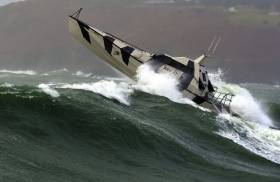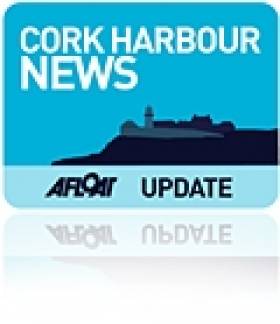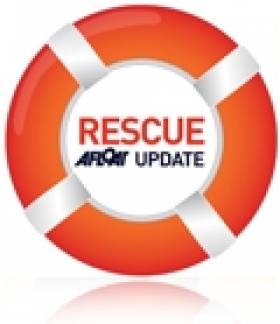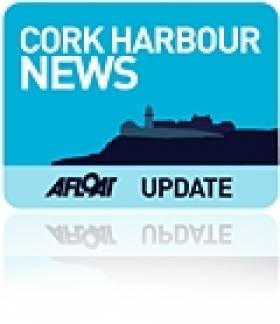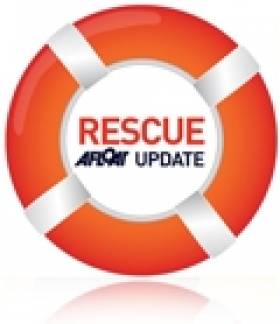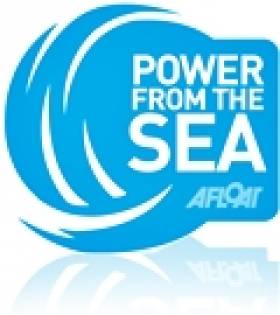Displaying items by tag: Safehaven Marine
Thunder Child Takes On Storm Doris In Cork Harbour
#ThunderChild - Storm Doris’s high winds on Thursday (2 February) made the perfect conditions for testing Safehaven Marine’s latest state-of-the-art naval patrol vessel in Cork Harbour, as the Irish Examiner reports.
Test pilot Ciaran Monks was at the helm of Thunder Child amid 50-knot winds and six-metre waves in what crew member Mary Power said were “by far the roughest conditions she’s encountered since her launch before Christmas”.
As previously reported on Afloat.ie, Thunder Child was launched for tests in December in preparation for an attempt to break the record for the fastest circumnavigation of Ireland — with an open-sea loop via Rockall to boot.
The Irish Examiner has more on the story HERE.
Safehaven Marine's sleek Thunder Child interceptor tackling 6m waves in 50knt winds at the mouth of #Cork Harbour today #StormDoris pic.twitter.com/2yj8tZIuOx
— Eoin English (@EoinBearla) February 2, 2017
Safehaven’s ‘Thunder Child’ Put Through Its Paces In Stormy Cork Harbour
#ThunderChild - Stormy winter seas made the perfect proving ground for a new state-of-the-art naval patrol and rescue vessel tested in Cork Harbour recently, as the Irish Examiner reports.
But it’s just the beginning for Thunder Child – the latest high-tech design from Cork-based Safehaven Marine, makers of the James Bond-style Interceptor, Barracuda – which was launched from the Port of Cork last month.
Safehaven’s managing director Frank Kowalski has his sights set on breaking the record for the fastest circumnavigation of Ireland — including a 1,000km open-sea loop around Rockall.
And considering the sleek wave-cutting vessel has already clocked speeds of over 100kph in testing, and is kitted out to handle the stormiest situations, it should be well up to the task of that challenging route.
The Irish Examiner has more on the story HERE.
#safehaven – Now here's is a harbour-hog deterrent to absolutely Die Another Day for. Afloat.ie reported on the The Bond-style interceptor earlier this month, the brand new design boasts a 40-plus knot top speed, stealthy low-radar profile, nightvision cameras, ballistic crew protection and even a remotely controlled machine gun that pops up from below deck.
Above is the latest promotional video of Barracuda, an 11-13m, high speed low RCS Interceptor / patrol vessel built in Cork.
But rather being the brainchild of MI6's gadget quartermaster, the Barracuda is the latest design from Cobh-based pilot boat specialists Safehaven.
Following a year and a half of design development and building work at its hi-tech manufacturing facility in East Cork, Cobh-based Safehaven Marine has unveiled the prototype of its latest design. And she's as mean as she looks!
#safehaven –A €1m-plus stealth style Irish built military vessel is creating waves along the Cork coast. 'Barracuda' is a new high speed Interceptor/Patrol vessel for military and law enforcement applications designed and built by Cork Harbour's Safehaven Marine.
Following a year and a half of design development and building work at its hi-tech manufacturing facility in East Cork, Cobh-based Safehaven Marine has unveiled the prototype of its latest design. And she's as mean as she looks!
Safehaven Marine is one of the world's top manufacturers of pilot boats and rescue vessels, and now the company hopes to use this new design to branch in to the world's military market.
The vessel can be produced at lengths of between 11 – 13m. Typical operational roles include patrol and surveillance duties around harbour installations and offshore anchorages, as well as high speed pursuit and apprehend when required. An array of both lethal and non lethal weapons can be carried concealed below decks in a separate compartment in the forward cabin, and raised when required. The vessel can be deployed by helicopter utilising its in-built lifting points on deck and at its 11m length, transported easily by ship or road.
Propulsion on the 11m version featured here is by conventional stern gear supplied by Clements Engineering and chosen for its weight carrying capabilities and durability, alternatively water jets can be fitted for higher speeds and low draft. Capable of maximum speeds of 40kts+ depending on the propulsion system and equipment installed, 'Barracuda' is fitted with a pair of Caterpillar C9 diesel engines rated at 560hp supplied by Finnings UK.
The innovative design of the vessel utilises various stealth technology's to produce a lower RCS (radar cross section), allowing it to operate with reduced degree of visibility to an adversary's radar. The design uses an innovative solution to weapon deployment. Various different types of both lethal and non-lethal weapons, including a remote control gyroscopically stabilised machine gun can be fitted to Barracuda. (A non functioning replica is fitted to the prototype featured here for demonstration purposes) In Barracuda the weapons are cleverly concealed below decks in the f/wd section of the superstructure, and are raised up to above deck level for deployment through large watertight carbon fibre hatches built into the f/wd cabins roof section. In this way when the vessel is in engaged in surveillance or patrol, the weapons are concealed and the vessels RCS signature is reduced. When the vessel is engaged in pursuit or apprehend modes, the weapons are raised for deployment.
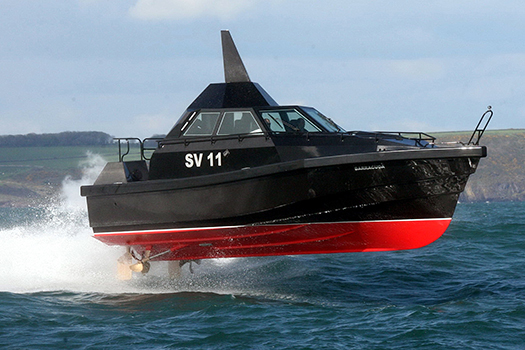
Airborne – Barracuda is powered by twin 560hp Caterpillars giving her lift off at a top speed of 38–knots for this Cork Harbour photo shoot
Another advantage being that the weapons are hidden when not in use for security, durability and covert reasons, as well as greatly reducing the vessels VCG when beneficial, such as in heavy weather. The superstructure and hull design utilises flat plane principles to its surfaces in its f/wd and side projections to deflect radar beams away from source, which together with specialized construction and outfitting, which include minimal metallic fittings exposed above decks, or where necessary being fully recessed. All of which combine to produce a vessel with a significantly lower than normal RCS.
The design however does not compromise on practicality or usability and provides for a high level of crew safety (wide side decks) for offshore boarding capabilities.
The vessel is constructed from advanced lightweight FRP cored composites, with extensive use of carbon fibre in its outfitting. Substantial in size yet lightweight Manuplas foam cored fenders with a polyurethane skin are used to minimise weight and offer maximum protection to the hull. The vessel can be moulded at lengths between 11m and 13m, and has a 4m beam, longer length versions benefit from a longer aft cockpit providing an increased working / crew area. The hull design below the waterline is an all new constant deadrise, twin chine deep V hull form capable of high speeds. A 22 degree deadrise at the transom and a wave piercing bow form, with a very fine wave cutting waterline entry at the bow of 70 degrees, which very effectively minimizes vertical accelerations at speed in waves, thereby maximising crew endurance. The hull provides exceptionally high levels of seakeeping abilities on all course, very much as one would expect from a builder renowned for its highly seaworthy pilot and S.A.R. vessels. The hull's special spray rail and twin chine arrangements provides for excellent spray suppression and on deck dryness, and her wide beam provides high levels of dynamic and static stability.
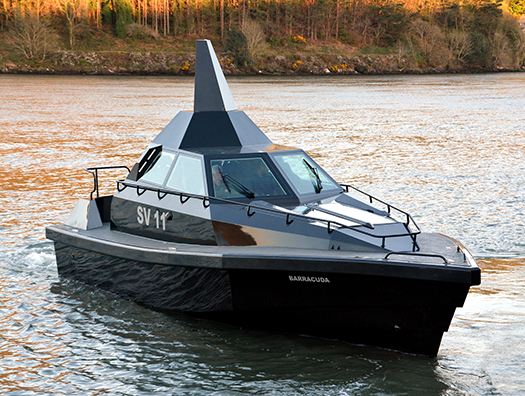
Not out of place in a James Bond film. This totally new hull has a constant deadrise Deep V with a wave piercing bow. Safehaven marine say they are just exploring its sea keeping abilities, but early reports say 'fantastic so far'! There is a really soft ride into a sea (see below) and good down wind in following seas even with such a fine bow
The design is capable of operating in up to sea state 7-8, and maintain operational speed in sea state 4-5, and can accommodate a crew of 4-6 in her main cabin, all on high tech shock mitigation seating supplied by X Craft, Holland.
As well as a full array of navigation equipment, a range of sonar equipment can be installed to monitor the underwater situation. FLIR Thermal and night vision infrared cameras are integrated for surveillance. A full digital Can Buss electrical system supplied by ETA has been integrated with all onboard systems controlled by touch screen computers at the helm and navigators positions, and expandable to potentially allow all crew members the ability to monitor and control the vessels navigation and onboard systems. Optionally ballistic protection can be incorporated to provide protection to the crew compartment utilizing lightweight composite ballistic panels. The front and side glass is ballistic and is directly bonded into moulded recesses without metallic frames. Barracuda will be produced alongside Safehaven's highly successful existing range of pilot, SAR vessels and patrol boats.
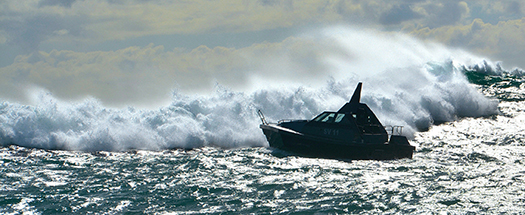
Big seas. Big test. 'Barracuda' during rough weather sea trials taking a pretty large breaking wave. Designed to have high levels of seakeeping and, depending on specification, she can be self righting as is the prototype here. Barracuda is 11m length overall. The top of the mast is 4.2m above the waterline so.... is this a 6m wave?...
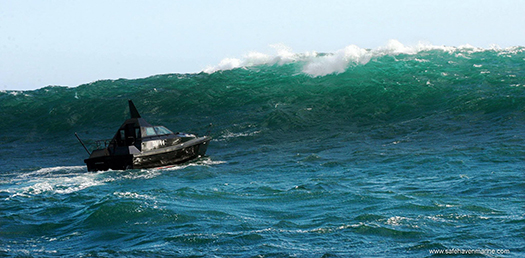
....Yep..... it sure is..... pass the sickbag please!
Cork Boat Builder Puts Its Vessels To The Test In Atlantic Storm
#Search&Rescue - Surfers haven't been the only ones benefitting from the recent stormy weather, as RTÉ News reports on a Cork-based boat builder that's been testing its top models in the wild Atlantic swell.
Youghal-based search-and-rescue (SAR) and pilot boat builder Safehaven Marine took its SAR vessels based at Roche's Point in Cork Harbour to the limit during sea trials earlier this week. Click HERE to see video of the sea trials in action
It follows similar trials of the company's pilot boat Interceptor 48 late last month as conditions turned for the worse off the Cork coast.
In waves reaching heights of 20 metres and winds breaking the 100km/h mark, the boats were tested in the extreme this week, but it was more than necessary for the hard work they'll be put through in service.
RTÉ News has more on the story HERE.
Safehaven's Pilot Boat 'Interceptor 48' Tested in Storm Force Conditions
#storm – December storms provided Cork harbour boatbuilder Safehaven Marine with the perfect test bed for sea keeping trials with winds of Force 12 and near 30ft waves off the coast of Cork Harbour. On test was Safehaven's Interceptor 48, a self-righting pilot/ Search and Rescue vessel.
Almost the ultimate conditions prevailed for the test, storm force winds of a sustained duration and fetch creating mountainous seas nearly 30ft high, a strong ebb tide running out against the waves creating a maelstrom of steep breaking waves over the harbour rock at the entrance to Cork Harbour, all combined with perfect visibility.
Safehaven Managing director Frank Kowalski told Afloat, 'I think this video portrays the immense power and danger of the sea'. It certainly does and it also shows the seakeeping abilities of Safehaven's Interceptor pilot and rescue designs.
New Irish Built Search & Rescue Craft Capsize Tested with Designer Inside
The Cork Harbour based Safehaven Marine, specialist builders of pilot boats and rescue vessels have undertaken probably an industry first, by capsizing their latest Interceptor 48 Pilot / S.A.R. vessel in a live condition with two crew inside during the roll over.
In the ultimate expression of confidence in the vessels design and integrity, Safehaven's managing director and designer, Frank Kowalski, volunteered to be inside the vessel during the roll over. Strapped in with a full harness at her helm position he commented "it was a bit stressful when she was over at 90 degrees about to go over, and the motion past 180 during recovery was pretty violent, but it went off without a problem"
The above youtube video Safehaven made with multiple cameras both inside and outside during the test makes very interesting viewing in clearly showing the forces involved.
Look closely and you can see her crew inside at the time.
Monster Wave Hits Cork But Local Heroes Rise Above it
#corkharbour – Back in 1992, we were sailing a true cruiser-racer which was moderately competitive despite going off for a proper cruise or two each year. In that year we did Cork Week and lived aboard the boat in true cruiser-racer fashion – in fact, the security man checking my pass at the end of the week said it showed I'd never gone to the landward side of the Royal Cork compound throughout the regatta, which on reflection I had to say was indeed true.
Anyway, on that last day before I finally ventured into nearby County Cork, we had a breezy race with lots of wind between south and southwest, and as the ebb was running hard I can remember taking it easy going out to the start, because for once we had time in hand and the space to avoid the tide rip which develops in those conditions off Roche's Point.
We were trundling along, and suddenly Ted Crosbie's boat (it would have been one of his earlier excursions into the X Boats) came rocketing past heading seaward at full speed carrying all sail. His start was earlier than ours, and he was late. It may be that he wanted to teach whoever had kept him late a fierce message, or maybe he did it for the hell of it, but he just went straight through the breakers at full chat (despite his affable appearance, Ted is one tough cookie) and came out the other side still going strong, and with us marvelling that his boat was still in one piece, and joking about the citizens of Cork having such an excellent boat test tank right on their doorstep.
Mock not, lest your predictions come true. Since 2006, Frank Kowalski and his team at Safehaven Marine in Cobh have been putting their Pilot and Search & Rescue boats through the demanding test bed off Roche's Point, and the success of the company is testament to the thorough nature of the conditions experienced when there's an onshore gale and the ebb is running strong.
It all started with a boat for Cork Harbour, though I should imagine the Cork Harbour authorities have mixed feelings about the way the entrance to their "safest harbour in the world" is now being used to publicise the marque. But fair play to the men of Cork, they backed a winner, and these days the Safehaven boats are sold to harbour authorities and other maritime bodies all over the world, with the company employing 25 highly skilled staff between their factories on Little Island in Cork Harbour, and in Youghal.
It's very much a team effort, and usually when they want to take a boat out to test, other boats may go along to observe and photograph. But if things are just too much, or the factories are extra busy, all they need is one guy with a camera down on Roche's Point.
This recent sequence was taken from another boat, and it shows former naval diver Ciaran Monks putting the newest in the sequence of pilot and rescue vessels through her paces. For once, the word awesome can be allowed. No other word will do. Frank Kowalski and his team are an inspiration to us all.
Cobh Built Pilot Boats Face Big Wave Test off Cork Harbour
A summer gale provided the perfect test bed for Sea trials of pilot and rescue boats in Cork Harbour in August. Two Interceptor pilot boats were put through their paces in a big storm with 10m breaking seas off Roches Point, Cork on 16 August 2012, by their builders Safehaven Marine of Cobh.
The boats are designed and built by Frank Kowalski's Safehaven Marine Ltd of Cobh who employ 25 people in two factories that produce pilot vessels for port authorities.
Husky Returns from North Sea Wind-Farm
#POWER FROM THE SEA – Wicklow based Island Shipping's twin-screw tug Husky returned to her homeport last month having completed a 300-day charter at the Sheringham Shoal Offshore Wind-farm in the North Sea, writes Jehan Ashmore.
The multi-purpose 10 tonne bollard pull tug had provided logistical support to and from turbines and sub-stations at the SCIRA (Statoil & Statkraft) windfarm off the north Norfolk coast.
She leaves two of her fleetmates Island Tiger and Island Panther, a pair of 23-knot Wildcat 53 wind-farm support vessel (WFSV) catamarans based at the Sheringham Shoal where they are engaged in 24/7 crew transfer operations. In the meantime the Husky is now available for charter.
As previously reported they had previously worked at the Greater Gabbard Offshore Wind-farm in the North Sea after each of the 16m newbuilds where completed by Safehaven Marine in Cork.




























